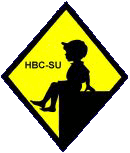
HBC has little information about Belgian boys wearing smocks. HBC believes, however, that smocks styles and usage in Belgium generally followed the pattern in France. Smocks were very commonly worn by Belgian school children. Unfortunately, HBC has not yet been able to find much information on Belgian smocks. This is a serious limitation on out national smock coverage because we believe that Belgium is one of the countries where smocks wre most commonly worn. Hopefully a Belgian reader will contribute some information on school smocks.
Belgium is a bilengual country with both French and Dutch being spoken. We believe that French speaking Bwlgians referred to a school smock as a "tablier" as was case in France where school smocks were also common. We know that French-speaking Belgians did commonly wear smocks. We are less sure about the Dutch speaking Flemish. Boys in Flanders also wore school smocks, bur we do not know if it was as common as boys in Flemish speaking Walonia. They like the Dutch presumably referred to school smocks as "kiel" or "kieltje", although "schort" or "schortje", also meaniing apron, appears to have been more common in Flanders. The plural is "schortjes". Peasant smocks called "boerenkiel" (kiel=smock for boeren=peasants) were common in rural areas until about the mid-1930s.
HBC believes that smock became common in Belgium at about the same time as in France--the 1870s. We have, however, very little actual information. Very limited information is available at this time on Belgian smocks. We do not know if the smocks were introduced by law. This was the case in France when smocks were introduced by the French Third Republic as a measure to make the schools more eqalitarian.
HBC had begun to collect some basic chronological date. We believe that Belgian school smocks basically followed French trends. Belgium of course was a monarchy. Thus we do not know if smocks appeared in Belgium by government decree or just the cultural influence of France. Hopefully some of our Belgian readers will provide us some infprmation on this. Some indivisual schools may have required them. We do not yet have a large enough Belgian archive to know how common it was. Or to know if smocks were required or just an option available to parents. We do know that large numbers of Belgian school children did wear smocks. The styles we see at mid-century seem all back-buttoning smocks. We do not see white collars and nows, but our archive is very limited. Some images suggest tht they wserw not required. HBC believes that the styles and popularity was similar in France and Belgium, at least among French speakers. We are sure, however, to what extent French styles were worn by Flemish boys and if this changed over time. Smocks were commonly worn by school children through the 1940s. We think that thatv smocks were worn into the 1950s, but do not think that they were very common.
We have noted Belgian boys in the early 20th century wearing dark school smocks woth large whote collars. These collars, of course, were not part of the smocks, but blouses or detachable collars worn over the smocks. By the inter-war period we notice both smocks with and without collars. A French reader points out that one reason collarless smocks were so popular was that they were much easier to make than smocks with collars. Many mothers in the inter-war period made the clothes for their younger children, especailly children before the teen years. Mother varied greatly in their sewing skills. Patterns that could be made without a lot of complications were particularly popular. Thus a lot of the patterns in sewing magazines were colarless smocks.
Belgian schools also adopted French-style school smocks, following the decission of the French Third Republic in the 1870s. Smocks were this widely worn in Belgium through the early 20th century. Belgian school smocks are very similar to French smocks. They also appear to have followed the same chronological trends. Early Belgian school smocks were long
dark smocks just like French smocks. Belgian smocks in the post-World War II era also seem to be very similar to French smocks. A French reader writes, "The
Belgian school tabliers were exatly the same as those found in France. The model (figure 1) was primarily for a boy (garçonnet) Notice the length, how it should be
worn, and the typical pleats." HBC know of no significant difference between Belgian and French school smocks.
School smocks in Belgium were very commonly worn by both boys and girls.
A Dutch reader tells HBC that smocks were not only worn for school, but also commonly worn at home. Presumably, as with school smocks, we believe that this was most common with French speaking families.
A particularly important source on Belgian school smocks and other early and mid 20th centuru fashions is the Flemish (Dutch language) sewing and fashion magazine "Vrouw en Huis" ("Woman and Home"). The magazine was an important source of fashion information for Belgian and Dutch mothers. While the magazine was in Durch, we noted that some of the fasghions picture are very French looking school smocks.
Navigate the Historic Boys' Clothing Web Site:
[Introduction]
[Activities]
[Bibliographies]
[Biographies]
[Chronologies]
[Countries]
[Style Index]
[Contributions]
[Expanded Site]
[Frequently Asked Questions]
[Glossary]
[Images]
[Links]
[Registration]
[Boys' Clothing Home]
Navigate the Historic Boys' Clothing Web chronological pages:
[The 1890s]
[The 1900s]
[The 1910s]
[The 1920s]
[The 1930s]
[The 1940s]
[The 1950s]
[The 1960s]
Navigate the Historic Boys' Clothing Web style pages:
[Return to the Main school smock countrypage]
[Return to the Main smocks page]
[Return to the Main Belgian school garment page]
[Dresses]
[Bodice dresses]
[Kilts]
[Smocks]
[Sailor suits]
[Sailor hats]
[Ring bearer/page costumes]
[Pinafores]
[Shortalls]
